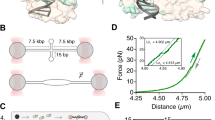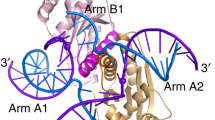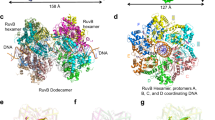Abstract
The four-way DNA (Holliday) junction is the central intermediate of genetic recombination, but the dynamic aspects of this important structure are presently unclear. Although transitions between alternative stacking conformers have been predicted, conventional kinetic studies are precluded by the inability to synchronize the junction in a single conformer in bulk solution. Using single-molecule fluorescence methodology we have been able to detect these transitions. The sequence dependence, the influence of counterions and measured energetic barriers indicate that the conformer transition and branch migration processes share the unstacked, open structure as the common intermediate but have different rate-limiting steps. Relative rates indicate that multiple conformer transitions occur at each intermediate step of branch migration, allowing the junction to reach conformational equilibrium. This provides a mechanism whereby the sequence-dependent conformational bias could determine the extent of genetic exchange upon junction resolution.
This is a preview of subscription content, access via your institution
Access options
Subscribe to this journal
Receive 12 print issues and online access
$189.00 per year
only $15.75 per issue
Buy this article
- Purchase on Springer Link
- Instant access to full article PDF
Prices may be subject to local taxes which are calculated during checkout




Similar content being viewed by others
References
Cox, M.M. et al. The importance of repairing stalled replication forks. Nature 404, 37–41 (2000).
Holliday, R. A mechanism for gene conversion in fungi. Genet. Res. 5, 282–304 (1964).
Potter, H. & Dressler, D. On the mechanism of genetic recombination: electron microscopic obervation of recombination intermediates. Proc. Natl. Acad. Sci. USA 73, 3000–3004 (1978).
Schwacha, A. & Kleckner, N. Identification of double Holliday junctions as intermediates in meiotic recombination. Cell 83, 783–791 (1995).
Lilley, D.M.J. & White, M.F. The junction-resolving enzymes. Nat. Rev. Mol. Cell. Biol. 2, 433–443 (2001).
Lilley, D.M.J. Structure of helical junctions in nucleic acids. Q. Rev. Biophys. 33, 109–159 (2000).
Clegg, R.M., Murchie, A.I.H. & Lilley, D.M.J. The solution structure of the four-way DNA junction at low-salt conditions — a fluorescence resonance energy transfer analysis. Biophys. J. 66, 99–109 (1994).
Duckett, D.R. et al. The structure of the Holliday junction, and its resolution. Cell 55, 79–89 (1988).
Murchie, A.I. et al. Fluorescence energy transfer shows that the four-way DNA junction is a right-handed cross of antiparallel molecules. Nature 341, 763–766 (1989).
Nowakowski, J., Shim, P.J., Prasad, G.S., Stout, C.D. & Joyce, G.F. Crystal structure of an 82-nucleotide RNA–DNA complex formed by the 10–23 DNA enzyme. Nat. Struct. Biol. 6, 151–156 (1999).
Ortiz-Lombardia, M. et al. Crystal structure of a DNA Holliday junction. Nat. Struct. Biol. 6, 913–917 (1999).
Eichman, B.F., Vargason, J.M., Mooers, B.H.M. & Ho, P.S. The Holliday junction in an inverted repeat DNA sequence: sequence effects on the structure of four-way junctions. Proc. Natl. Acad. Sci. USA 97, 3971–3976 (2000).
Mueller, J.E., Kemper, B., Cunningham, R.P., Kallenbach, N.R. & Seeman, N.C. T4 endonuclease VII cleaves the crossover strands of Holliday junction analogs. Proc. Natl. Acad. Sci. USA 85, 9441–9445 (1988).
Bennett, R.J. & West, S.C. RuvC protein resolves Holliday junctions via cleavage of the continuous (noncrossover) strands. Proc. Natl. Acad. Sci. USA 92, 5635–5639 (1995).
Miick, S.M., Fee, R.S., Millar, D.P. & Chazin, W.J. Crossover isomer bias is the primary sequence-dependent property of immobilized Holliday junctions. Proc. Natl. Acad. Sci. USA 94, 9080–9084 (1997).
Grainger, R.J., Murchie, A.I.H. & Lilley, D.M.J. Exchange between stacking conformers in a four-way DNA junction. Biochemistry 37, 23–32 (1998).
Chen, J.H., Churchill, M.E., Tullius, T.D., Kallenbach, N.R. & Seeman, N.C. Construction and analysis of monomobile DNA junctions. Biochemistry 27, 6032–6038 (1988).
Carlstrom, G. & Chazin, W.J. Sequence dependence and direct measurement of crossover isomer distribution in model Holliday junctions using NMR spectroscopy. Biochemistry 35, 3534–3544 (1996).
Overmars, F.J.J. & Altona, C. NMR study of the exchange rate between two stacked conformers of a model Holliday junction. J. Mol. Biol. 273, 519–524 (1997).
Weiss, S. Measuring conformational dynamics of biomolecules by single molecule fluorescence spectroscopy. Nat. Struct. Biol. 7, 724–729 (2000).
Zhuang, X.W. et al. Correlating structural dynamics and function in single ribozyme molecules. Science 296, 1473–1476 (2002).
Ha, T. et al. Initiation and reinitiation of DNA unwinding by the Escherichia coli Rep helicase. Nature 419, 638–641 (2002).
Johnson, R.D. & Symington, L.S. Crossed-stranded DNA structures for investigating the molecular dynamics of the Holliday junction. J. Mol. Biol. 229, 812–820 (1993).
Panyutin, I.G. & Hsieh, P. The kinetics of spontaneous DNA branch migration. Proc. Natl. Acad. Sci. USA 91, 2021–2025 (1994).
Mulrooney, S.B., Fishel, R.A., Hejna, J.A. & Warner, R.C. Preparation of figure 8 and cruciform DNAs and their use in studies of the kinetics of branch migration. J. Biol. Chem. 271, 9648–9659 (1996).
Panyutin, I.G., Biswas, I. & Hsieh, P. A pivotal role for the structure of the Holliday junction in DNA branch migration. EMBO J. 14, 1819–1826 (1995).
Parson, C.A., Stasiak, A., Bennett, R.J. & West, S.C. Structure of a multisubunit complex that promotes DNA branch migration. Nature 374, 375–378 (1995).
Ha, T.J. et al. Single-molecule fluorescence spectroscopy of enzyme conformational dynamics and cleavage mechanism. Proc. Natl. Acad. Sci. USA 96, 893–898 (1999).
Acknowledgements
We thank I. Rasnik for experimental help. Funding was provided by the NIH, NSF, Searle Scholars Award (T.H.) and by Cancer Research UK (D.M.J.L.). S.A.M. was partially supported by the NIH molecular biophysics training grant.
Author information
Authors and Affiliations
Corresponding author
Ethics declarations
Competing interests
The authors declare no competing financial interests.
Rights and permissions
About this article
Cite this article
McKinney, S., Déclais, AC., Lilley, D. et al. Structural dynamics of individual Holliday junctions. Nat Struct Mol Biol 10, 93–97 (2003). https://doi.org/10.1038/nsb883
Received:
Accepted:
Published:
Issue Date:
DOI: https://doi.org/10.1038/nsb883
This article is cited by
-
The influence of Holliday junction sequence and dynamics on DNA crystal self-assembly
Nature Communications (2022)
-
ABEL-FRET: tether-free single-molecule FRET with hydrodynamic profiling
Nature Methods (2021)
-
Freedom of movement
Nature Chemical Biology (2019)
-
Sites of high local frustration in DNA origami
Nature Communications (2019)
-
Junction resolving enzymes use multivalency to keep the Holliday junction dynamic
Nature Chemical Biology (2019)



